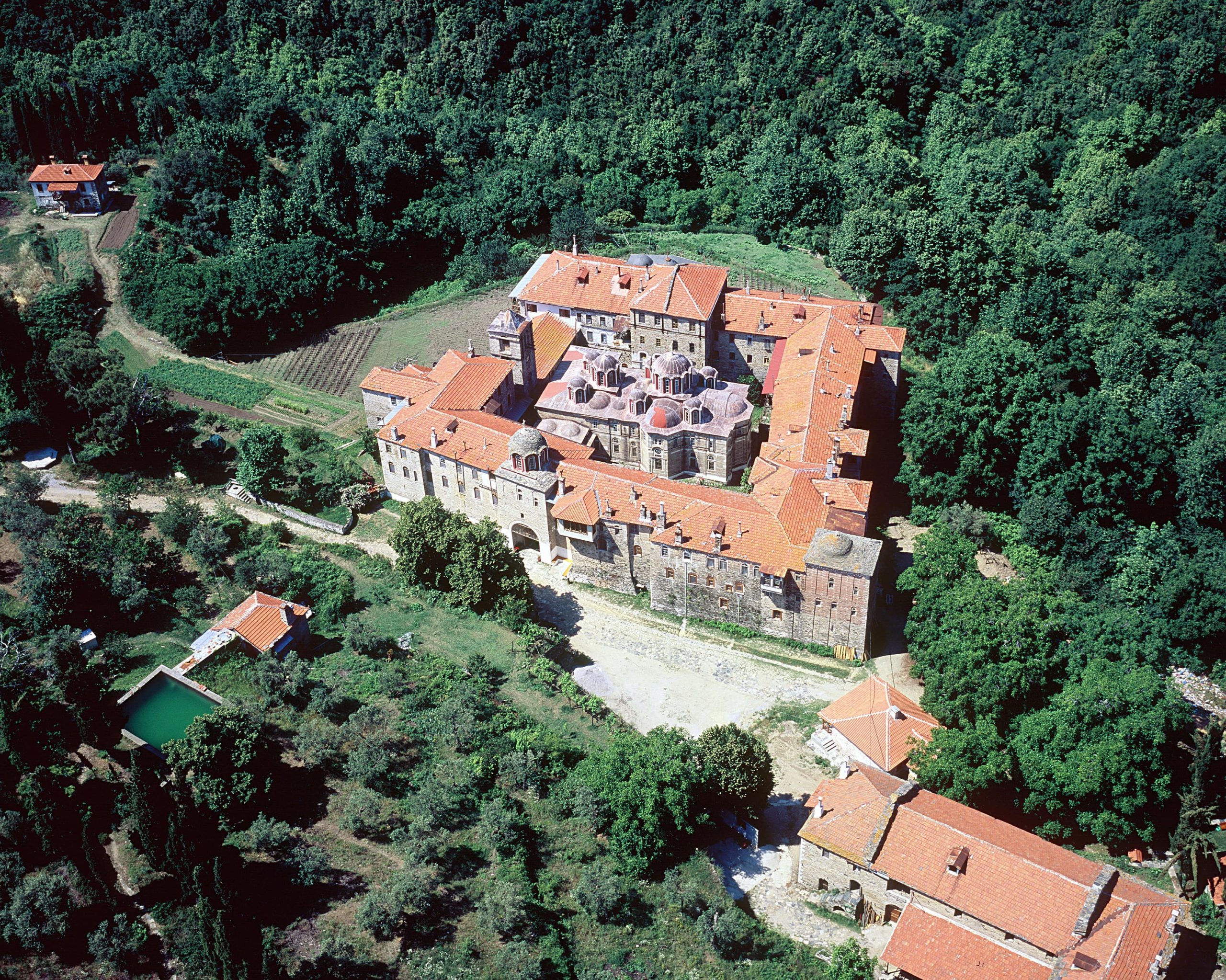
Konstamonitou Monastery, documented in Athonite documents since the 11th century, is located on the southwest side of the Athonite peninsula towards the Singitic gulf. Its buildings, mainly constructed after the middle of the 18th century as it was destroyed and restored several times over its long history, form a beautiful, typical Athonite monastery, characterized by simplicity in design, homogeneity and austerity, with the Katholikon of the monastery, built in 1867 and dedicated to St. Stephen, standing in the middle of the courtyard. Many portable icons of considerable historical and religious significance, manuscripts, important heirlooms and many relics are kept in the monastery. The Monastery ranks twentieth in the hierarchy of the Athonite Monasteries.
Dedicated to St. Stephen, the Kastamonitou or Konstamonitou monastery, as it is formally called, is perched on a beautiful wooded slope on the southwest side of the Athonite peninsula towards the Singitic gulf, between the Docheiariou and Zografou monasteries. Unseen from the sea, it can be reached after disembarkation at its arsanas (shipyard), followed by a 45-minute walk.
The Arsanas of the Monastery is a two-storey rectangular building of lean structure. The ground floor has a large arched opening to the sea where the ships of the Monastery were once kept; today, it serves as a storage area. Within a relatively short distance to the west, in the shadow of the remains of the imposing 14th century “Palaeopyrgos”, we can see traces of the old arsanas.
The ancient name of the monastery (Kastamonitou) is encountered in Athonite documents from the 11th to the 15th century and it probably reflects the origin of the founder of the monastery, a native of Kastamoni in Paphlagonia or perhaps his family name, as the name Kastamonites is encountered in several 11th century sources and is directly related to existing individuals.
The formal name of the monastery, Konstamonitou Monastery, is found in documents dating from 1349 onwards and is related to the legend preserved by the monastery regarding its establishment by Constantine the Great and his son Constant.
The absence of references to the monastery during the 12th and the first half of the 13th century indicates that it was probably a humble monastery, which, however, regained the status and privileges of an imperial monastery in the middle of the 14th century.
During the period of Ottoman rule, the monastery was faced with multiple disasters and repeated desolations, but it would always be restored with the contribution of prominent individuals. Practically ruined and abandoned in 1433, it was renovated by the Serbian general and later monk of the monastery, Radič; in 1728, the burnt eastern wing was rebuilt by priestmonk Anthimos, while in 1818-19, the northern wing was renovated with the donation of Kyra-Vassiliki, the Christian wife of Ali Pasha of Ioannina. Lastly, the present-day katholikon was built in the 19th century.
With the sole exception of the old dominating tower of the monastery which dates back to before 1569, the rest of the buildings of the monastery are more recent, built after the middle of the 18th century. The building complex forms a rectangle, with four wings enclosing a courtyard and the katholikon in the middle, as is common in Athonite monasteries. Without overly complex architecture, the Konstamonitou Monastery is characterized by morphological homogeneity and simplicity in design; hence, the overall pleasant yet austere look of its buildings.
The Katholikon of the monastery, dedicated to St. Stephen, was rebuilt in 1867 on the remains of earlier phases; it follows the typology of most katholikons on Mount Athos. Well cared for and thoroughly built of stone, it stands in the middle of the courtyard with its eight lead-covered domes projecting from the roof. The katholikon is not frescoed, except for a small part of the central dome, but there are numerous portable icons of particular historical and religious significance, such as the icon of the venerated St. Stephen, the icon of the Virgin Hodegetria, a gift from the Serbian Anna Philanthropene in 1360 and the miraculous icon of Panagia Antiphonetria.
111 manuscripts, of which 14 are written on parchment, as well as an extensive number of early printed books, are kept in the library of the monastery.
Important heirlooms are also kept in the monastery, such as a piece of the True Cross and several holy relics in silver reliquaries. One of the few 14th century embroidered Palaeologan epitaphs of Mount Athos is also preserved in the monastery.
The Monastery ranks twentieth in the hierarchy of the Athonite Monasteries. It has been cenobitic and in continuous operation from 1800 to date. In addition to the konaki (representative office) in Karyes, the monastery has two Kathismata as dependencies in the wider region.
Theodoros Dogas
Βιβλιογραφία
Actes de Kastamonitou, εκδ. N. Oikonomidès, Paris 1978
Σμυρνάκης Γ., Άγιον Όρος, Αθήνα 1903, 683-689
Nasturel Pierre, «A propos d’un document de Kastamonitou et d’une lettre patriarcale inconnue de 1411», Revue des études byzantines, τ. 40, 1982, 211-214
Alexander P. Kazhdan, ed., The Oxford Dictionary of Byzantium, Oxford: Oxford University Press, 2005, volume 2, λ. KASTAMONITOU MONASTERY, 1110.
Αθανασιάδης Γ, «Παλαιός και νέος αρσανάς της Ι. Μ. Κωνσταμονίτου», Άγιον Όρος και Θάλασσα, Θεσσαλονίκη 2003, 56-59.
Address: Konstantinoupoleos 5,
631 00 Polygyros Halkidiki
Phone: +30 23710 22060
Fax: +30 2310 251892
Mount Athos Technical Office
Address: 7 Hippodrome Square, Thessaloniki
Phone: +30 2310 285163
Fax: +30 2310 251892
E-mail: [email protected]
